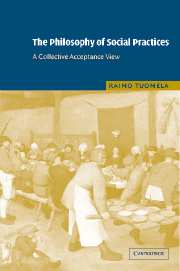Book contents
- Frontmatter
- Contents
- List of figures
- Acknowledgments
- Introduction
- 1 Collective intentionality and the construction of the social world
- 2 Collective intentionality
- 3 Conceptual activity, rule following, and social practices
- 4 An account of social practices
- 5 A Collective Acceptance account of collective-social notions
- 6 Social institutions
- 7 Social practices in a dynamic context: a mathematical analysis
- Epilogue
- Notes
- References
- Index
1 - Collective intentionality and the construction of the social world
Published online by Cambridge University Press: 22 September 2009
- Frontmatter
- Contents
- List of figures
- Acknowledgments
- Introduction
- 1 Collective intentionality and the construction of the social world
- 2 Collective intentionality
- 3 Conceptual activity, rule following, and social practices
- 4 An account of social practices
- 5 A Collective Acceptance account of collective-social notions
- 6 Social institutions
- 7 Social practices in a dynamic context: a mathematical analysis
- Epilogue
- Notes
- References
- Index
Summary
WIDE AND NARROW SOCIAL CONSTRUCTIVISM
The central claim of this book is that collective intentionality in the form of “shared we-attitudes” is crucial for the proper understanding of social practices and social institutions as well as sociality in general. The systematic elaboration of this grand thesis will occupy most of what follows. Underlying this central theme, and closely related to it, is that collective intentionality is also central for the ontology of the social world in that a central part of the social realm is collectively constructed in terms of “collective acceptance.” I will start by a brief discussion of this grand thesis, which can also be called the social constructivist program in the wide sense.
It may sound like a platitude to say that the social world is made and maintained by people by means of their social practices. Today the various views that fall under the label “social constructivism” emphasize the constructed nature of the social world. The construction can be performed on purpose or it can take place in part in terms of the unintended consequences of intentional action. As to modern literature related to social constructivism, I will not attempt to survey it here, nor will I take a stand on its various versions. I wish to emphasize that the physical world on my account, contrary to some other forms of constructivism, is not a social construct and that, furthermore, only some parts of the social world are intentionally collectively constructed.
- Type
- Chapter
- Information
- The Philosophy of Social PracticesA Collective Acceptance View, pp. 5 - 16Publisher: Cambridge University PressPrint publication year: 2002



